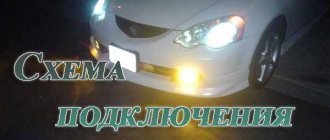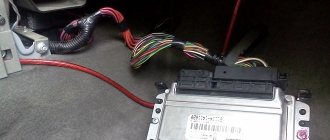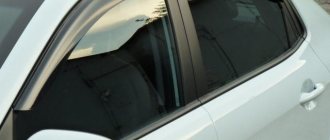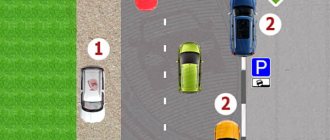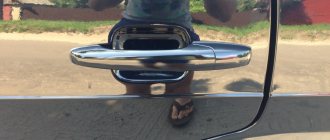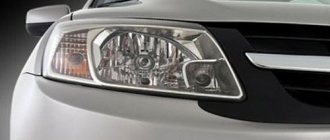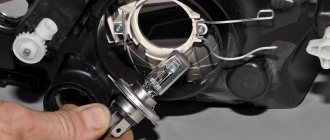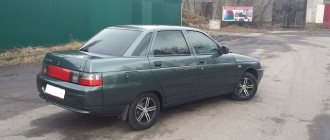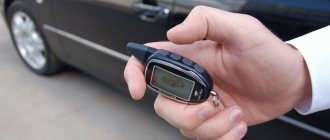Good afternoon, dear reader.
In the next article in the series “Pass the race track in half a kick” we will talk about an exercise that can safely be classified as difficult. It's called reverse parallel parking .
As for the second complex exercise, called entering the box in reverse, it was discussed in the previous article.
To be honest, parallel parking on a motorway is not much more difficult than other exercises, but most often driver candidates do not pass the traffic police exam precisely because of it. So let's look at the optimal order for completing this exercise, and also discuss common mistakes and problems:
- Exercise diagram.
- Execution order.
- Error table.
- Instructions for implementation.
- Instructions in pdf.
- Errors and problems in the exercise.
- Parallel parking in the city.
- Parallel parking on video.
New parallel parking rules in 2022
Now, according to the new regulations of 2022, passing the driving license test has become a little more difficult.
Now:
- The parking lot has decreased in size by 50 cm - it has become narrower. Length - 7.5 meters, width - 2.5 meters.
- The chips have been removed. Now the boundaries of the exercise are considered to be the boundaries of the parking space where the car needs to be parked.
- The technique of performing the exercise has not changed.
- The landmarks have been removed and now it is not clear how deep to go. That is, if earlier, in order to get into the parking lot, we drove our rear wheel onto the control line and turned the wheel to the left (or right), now there are no landmarks, but there is simply a drawn parking space, which complicates the exercise.
- The exercise was adapted to urban conditions as much as possible.
On the race track, step-by-step instructions
The order of execution according to the new regulations and for this purpose uses mirrors on the right (left):
- Choose the right landmarks to fit into the parking space, and if there are none, then follow the curbs.
- Maintain a lateral interval of 0.5 meters (it has not changed).
- Drive forward until the rear boundary of the parking lot closest to the road is visible in the rearview mirror. Ideally, the rear bumper is located near the nearest parking lot boundary.
- We turn on the reverse gear, the right turn indicator, turn the steering wheel to the right one turn (if the parking is located to the right of the car) and start driving.
- Drive until the far corner of the parking lot appears in the left rearview mirror.
- Stop the car and turn the wheels to the straight ahead position one turn to the left.
- Smoothly continue driving backwards until the left rear wheel (car cone or rear left handle) is level with the rear boundary of the parking lot located near the road.
- Stop.
- Turn the steering wheel all the way to the left and begin to move smoothly back.
- Stop when the front of the car is aligned with the left and right boundaries of the parking lot.
- Turn the steering wheel one and a half turns to the right.
- If necessary, move the car forward a little.
- Put the car on the handbrake or in the “Parking” position if the transmission is automatic.
- The exercise is over.
How to learn to feel the dimensions of a car
To begin to feel the dimensions of the car you need practice. There are no other magic methods. It is important not to be afraid to park, try to bring parking to the ideal, then the feeling of size will come.
We advise beginners not to be shy and to get out of the car as often as possible in order to visually control the distance to the curb or neighboring parked cars. This way you can avoid accidents and learn how to park. In addition, the side rear-view mirrors distort the distance to objects and it is difficult for a beginner to navigate solely by them. Go out and visually assess the distances, so you will learn to determine the dimensions of other cars.
If possible, practice in deserted areas, using cones or improvised objects, such as stones, as marking equipment.
In urban conditions, you can park later, when initial skills appear.
Moral and technical preparation
To successfully implement the task, it is important to feel the car and get used to its dimensions. If you have a spare tire hanging on the tailgate and a tow bar extending from the bottom of the rear end, keep this in mind.
If you forget about the trailer hitch, parallel parking in reverse can end in a banal accident and a hole in the bumper of another car.
When assessing the maneuverability of a vehicle, it is worth considering several criteria - the turning radius of the wheel, overhangs (rear and front), as well as the wheelbase.
The height of the curb is taken into account separately. If it is very large, attempts to park may result in damage to the body and costly repairs.
Now let's move on to technical preparation.
- The first thing to do is adjust the chair's inclination and height. The purpose of the adjustment is to achieve optimal visibility through the windshield (the road in front of the hood should be clearly visible).
- Adjust the back of the chair so that it is tilted at an angle of about 30 degrees. Depress every pedal and make sure you are comfortable.
- The levers should not be too close or, conversely, too far away. If you have to stretch or your knees rest on the steering wheel, the adjustment is not done correctly.
The next step is installing the steering wheel. The distance to your chest should be such that you can clearly see the dashboard and easily turn the steering wheel. The optimal position is when your back rests completely on the back of the chair, and your wrists reach the steering wheel.
The final stage of preparation is adjusting the mirror, which should fully reflect the rear window. When parking in reverse, this feature will be extremely important.
Adjust the side mirrors so that the rear door handle is visible on the left and right (lower part).
Key steps to remember
Special emphasis needs to be placed on some stages of parking:
- The space where the machine will be placed must correspond to its dimensions. At the same time, you need to realistically evaluate your parking skills.
- The positioning of the vehicle must comply with traffic regulations and signs.
- Before performing the maneuver, you need to make sure that there are no prohibiting signs or obstacles.
- Once the maneuver is completed, you need to make sure that no obstacles are created for other cars in the parking lot.
- When reversing, it is better to use the emergency lights. This way other drivers will be additionally warned about the maneuver.
Every driver should focus on 5 factors:
- Auto control.
- Traffic safety.
- Situations around the car.
- Compliance with the Rules.
- Behavior of other traffic participants.
Execution technique and penalty points
The first test for a novice driver is passing an exam, part of which may be parallel parking in reverse.
Parallel parking in reverse is a serious test; the performer is required to perform three actions:
- Drive up to the start line and brake in front of it;
- Move the car to an imaginary space between the cars;
- Stop the vehicle.
What technique the driver will use is not specified. Based on practice, this can only be done in reverse.
Each mistake results in penalty points:
- Touching or “falling over” marking elements, crossing a special line - five points.
- Failed to enter a side parking light (broken line) - five points.
- If during the race the engine stalls or the reverse gear is not disengaged after completing the maneuver - three points.
- The car is not put on the handbrake after stopping - three points.
Why are points reduced in the traffic police exam?
Today, the driving test includes several important exercises. One of them is called “Parking a vehicle and leaving a parking space.” This discipline tests skills that allow you to enter and exit a parking lot within a certain period of time without touching the marking equipment.
At racing tracks, special markings are installed, with the help of which assessment is carried out. All its cones and lines imitate the following real landmarks:
Name of the conePoint on the car bodyCar
| B | Left rear corner | standing in front |
| C | Left front corner | Rear |
| D | Right front corner | Rear |
This marking simulates a real situation, and therefore allows you to successfully perform such parking in the future.
When performing this exercise, errors are taken into account and the following penalty points are awarded:
- failure to complete the exercise within 2 minutes – 3 points;
- damage to fences, collision with solid lines – 3 points;
- the car did not cross the “CB” line - 3 points;
- engine stalled – 1 point.
If the examinee scores 3 penalty points, he fails.
Common Mistakes
Parallel parking in reverse is rarely possible for beginners due to a number of mistakes.
These include:
- Touching and “falling over” while moving chips installed on both sides.
- The car sits directly on the line, causing part of the vehicle to protrude from the pocket.
The chips get knocked down only in case of a hurry, when the driver tries to turn the steering wheel while moving. You can't act like that.
The steering wheel should only turn when it has come to a complete stop.
Problems with fitting into the available space occur for two reasons:
- The steering wheel rotates while moving.
- The stopping point is incorrect.
There is only one way to solve the problem - repeat the maneuver. In such a situation, you can get a penalty point, but the exam will not be failed.
The subtleties of parking in the city
Parallel parking in the city, and even in reverse, always involves certain risks.
To eliminate mistakes, it is important to strictly follow the step-by-step instructions and follow the prompts.
The main secret of parallel parking is entering. If beginners want to park, they simply drive through a parking space and then reverse. This approach is wrong.
When approaching a parking space, you need to turn on the right turn signal, “dive” into an empty space, and then drive out of it.
Below is a diagram of reverse parking between two cars.
After entering a “pocket,” you must continue driving until the right rear wheel is level with the bumper of the car in front. This way you will be able to take the most advantageous position for maneuver.
Now the steering wheel turns to the right and reversing begins. At the same time, monitor the “picture” in the left side mirror.
As soon as the headlight of the car standing behind you is visible, you can put the wheels straight.
Now the movement is carried out until the axis of the rear left wheel is aligned with the line connecting the outer dimensions of the front and rear cars.
Now you need to turn the steering wheel to the left as far as possible, and use the right mirror to control the distance between the wheel and the curb.
It is also worth looking at the front right side of the car to see if there is a risk of collision with another car.
Important rules for parking
- You cannot leave your car in the city where you want and how you want.
- To do this, there are certain places where you will not interfere with other road users and will not contradict traffic regulations.
- You need to get out of the car in such a way as not to damage it or anyone standing or passing nearby.
- You must always park your car on the right side on the side of the road or according to the pre-parking markings, and if there are none, on the edge of the roadway in one row.
- The easiest way to learn is on a specially prepared site. If there is none, you will need an empty street, a few empty cardboard boxes and free time. At first, leave more space between the boxes. If everything works out well, the space can be reduced.
Park correctly!
Frequent Questions and Answers
- Where can I park in the city? 5 meters before the pedestrian crossing; 5 meters from the edge of the crossed roadway; 15 meters from public transport stops; 50 meters from the railway crossing; in one row parallel to the edge of the roadway; at the very edge of the roadway or on the side of the road, if there are no prohibitory signs; in 2 rows at the edge of the roadway if you have a two-wheeled vehicle.
- Where should you not park your car? Closer than 5 meters to a pedestrian crossing; in places where stopping or parking makes it difficult for other drivers to see traffic lights; closer than 15 meters from public transport stops; at railway crossings and in tunnels, on the roadway if visibility is limited; at the intersection of roadways; on the tram tracks.
- What are the rules for parking a car? It is permitted on the right side of the road on the side of the road, and in its absence - on the roadway at its edge and in the cases established by paragraph 12.2 of the Rules - on the sidewalk. Parking on the left side of the road is permitted in populated areas on roads with one lane for each direction without tram tracks in the middle and on one-way roads. Parking is prohibited: - in places where stopping is prohibited; — outside populated areas on the carriageway of roads marked with sign 2.1; — closer than 50 m from railway crossings.
- How to park in the yard? Without blocking the passage of other vehicles, without leaving the car on the sidewalks, Make sure that you do not block the service entrance of the store. Also, vehicles can be parked no closer than ten meters from the doors.
- What is contact parking? Parking in which the bumper of a neighboring car touches. This type of parking is also called “French parking.”
- Is it possible to park a car on a triangle? Yes, if the parking and parking rules are not violated.
- Parking backwards, when to turn the steering wheel? You need to navigate along the trajectory of movement. Remember that the car reacts late when reversing, so you need to turn the steering wheel earlier than when driving normally.
- What are the dimensions of parallel parking? The width of the distance between the front and rear cars should be 1.5 meters
- How is parking performed on the opposite side? Parking is prohibited, except for the cases specified in subclause 19.1.3 of clause 19.1.
- Valet parking, what is it? Parking in which vehicles stand side by side, parking with their passenger doors facing each other.
- What is a closed parking lot? This is a parking lot equipped with barriers, gates, roller shutters, traffic lights, etc.
- It dripped onto the car from the ceiling of the parking lot, what should you do? Contact the persons responsible for parking safety. Until the issue is resolved, put a film on the car.
- Is it possible to park on a curve? It is not possible, since a stationary car will be an obstacle for other road users.
Sources
- https://infoselection.ru/infokatalog/avto-i-tekhnika/avtomobili/ekspluatatsiya-avtomobilya/item/506-kak-pravilno-parkovatsya-instruktsii
- https://www.gazu.ru/driving/parking/10321/
- https://avtopub.com/kak-parkovatsya-zadnim-hodom/
- https://AutoTopik.ru/sovet/1302-parallelnaya-parkovka-zadnim-hodom.html
- https://EvriKak.ru/info/kak-pravilno-parkovatsya/
[collapse]


